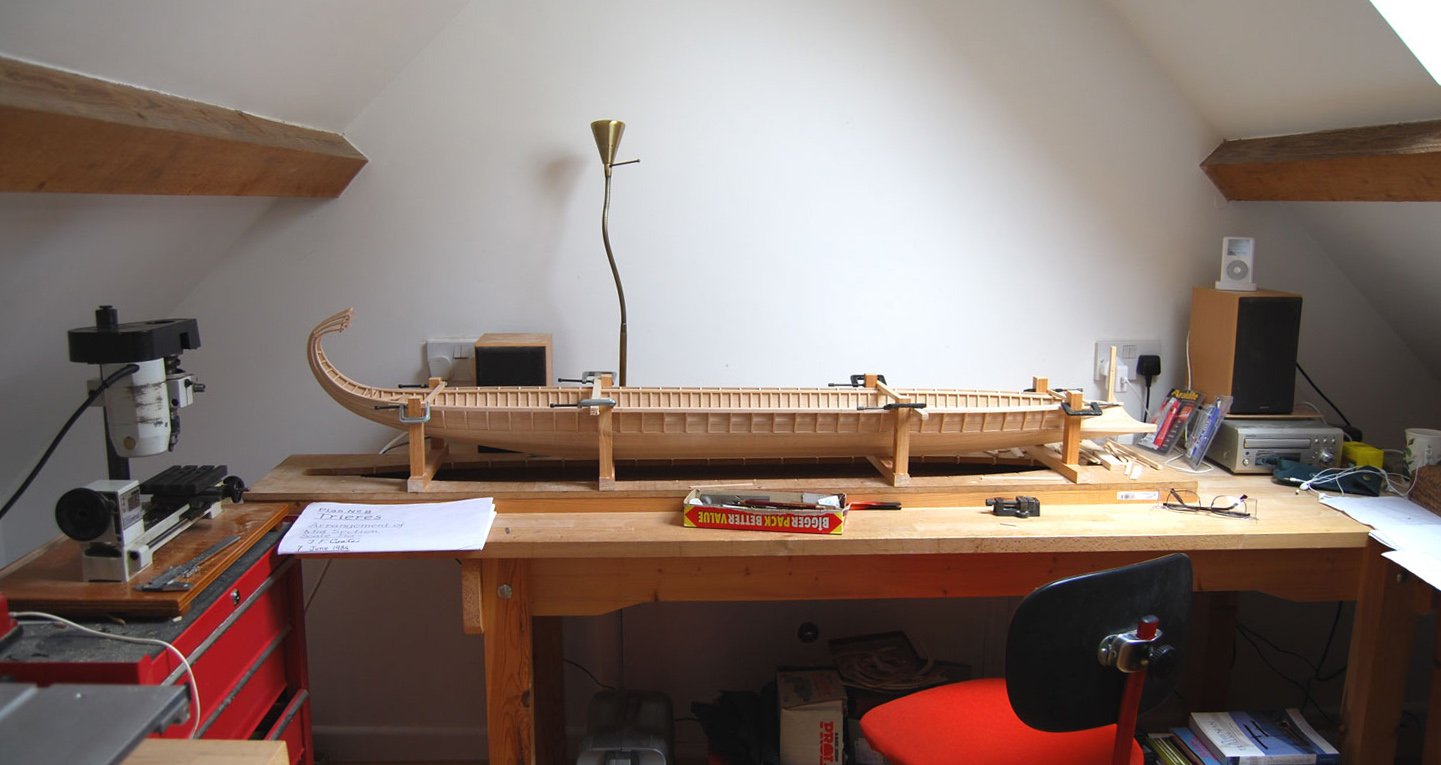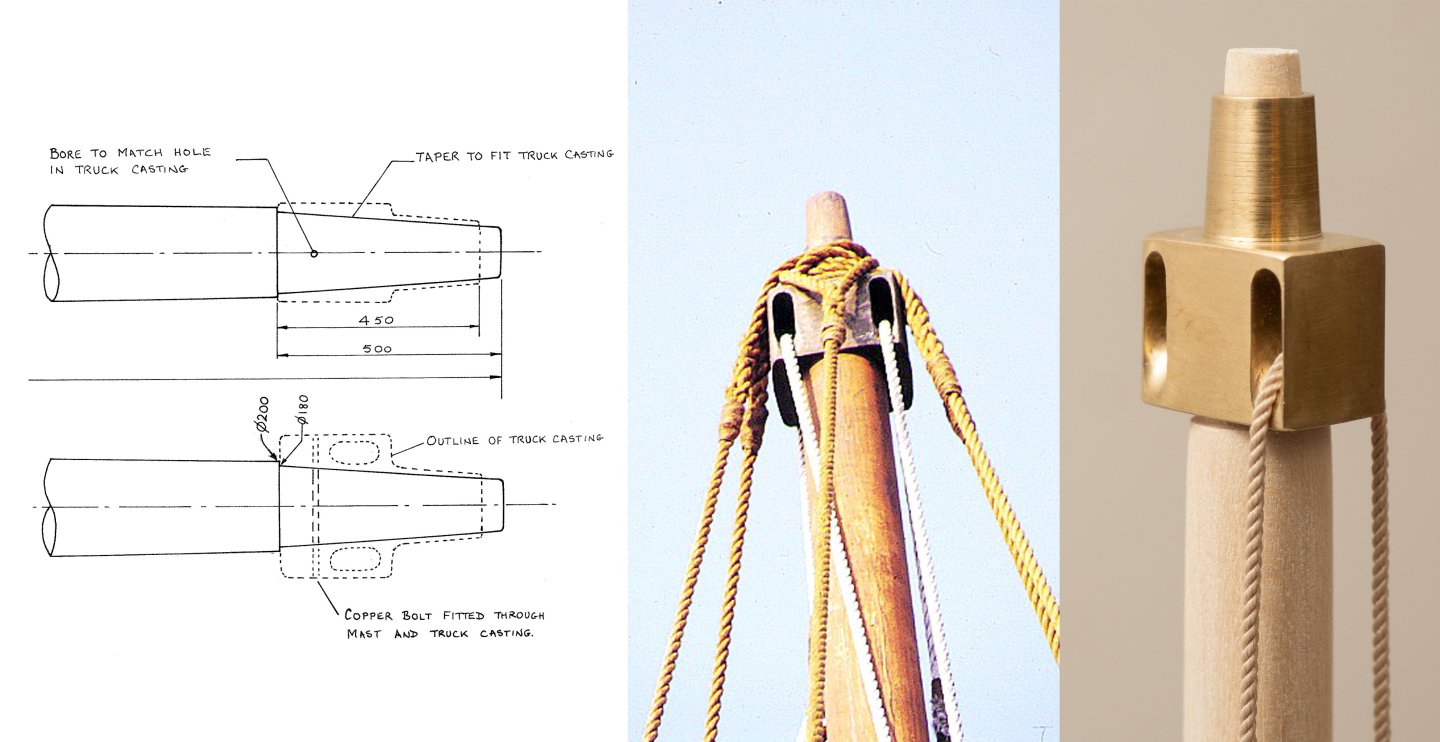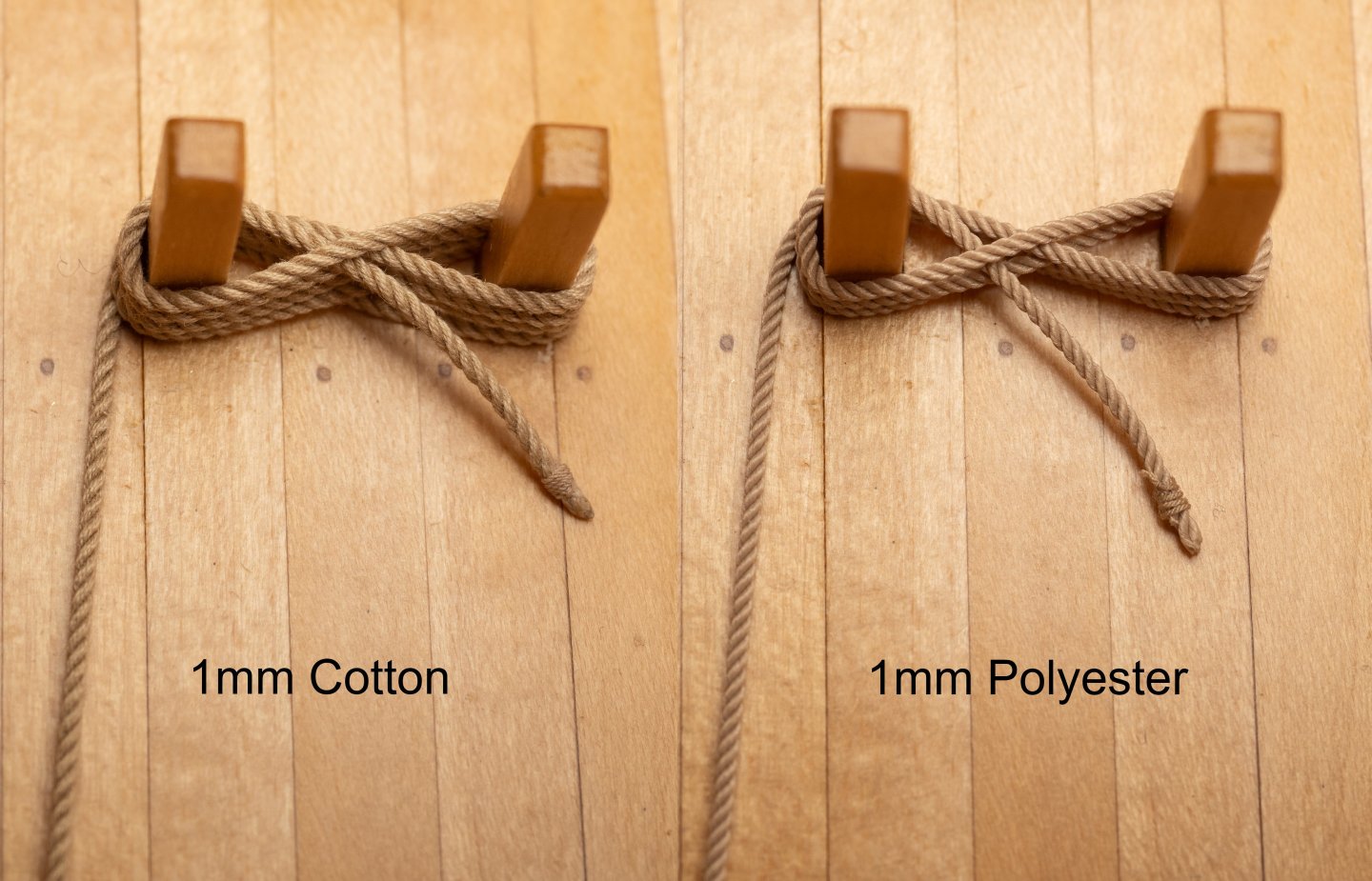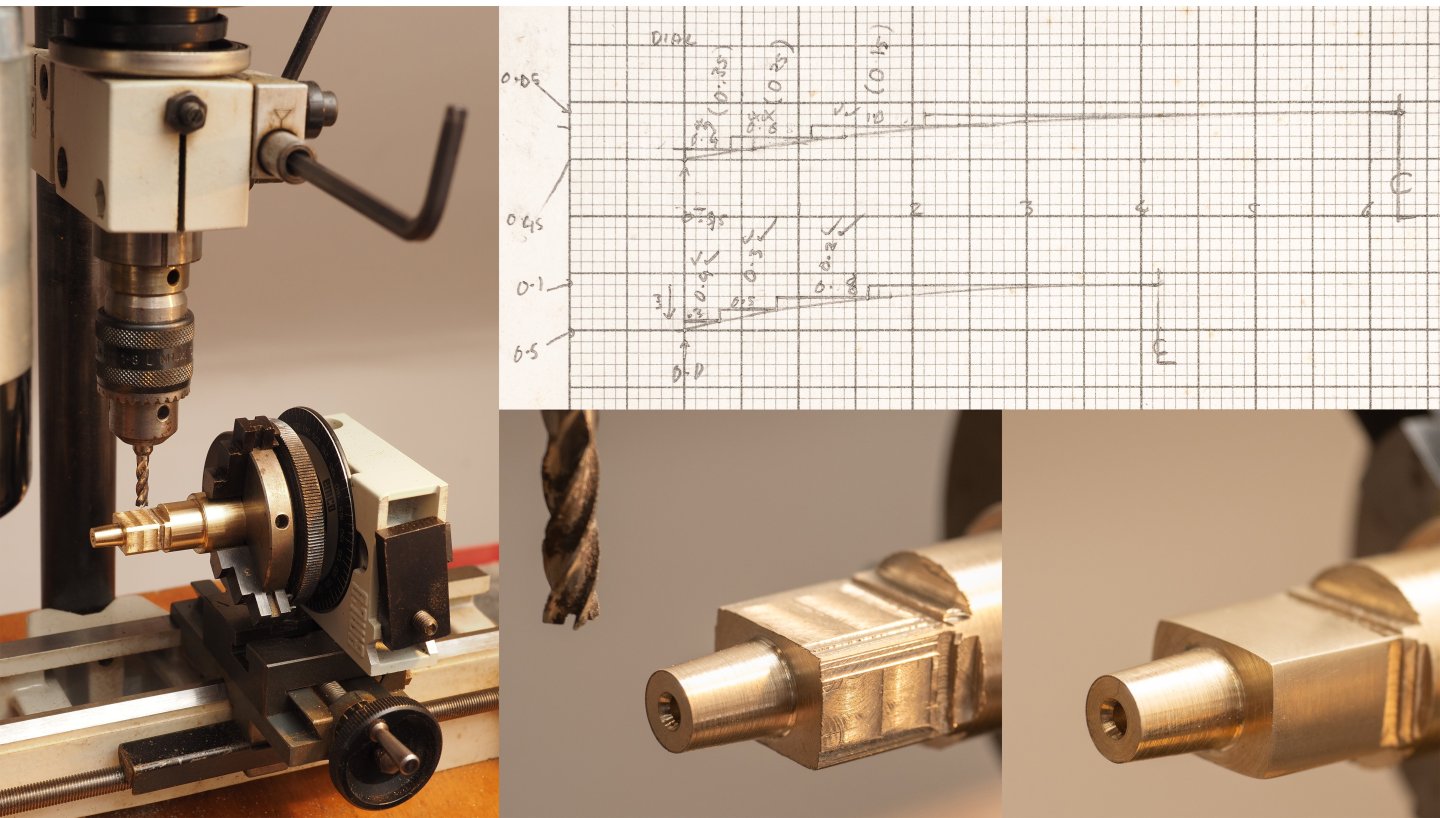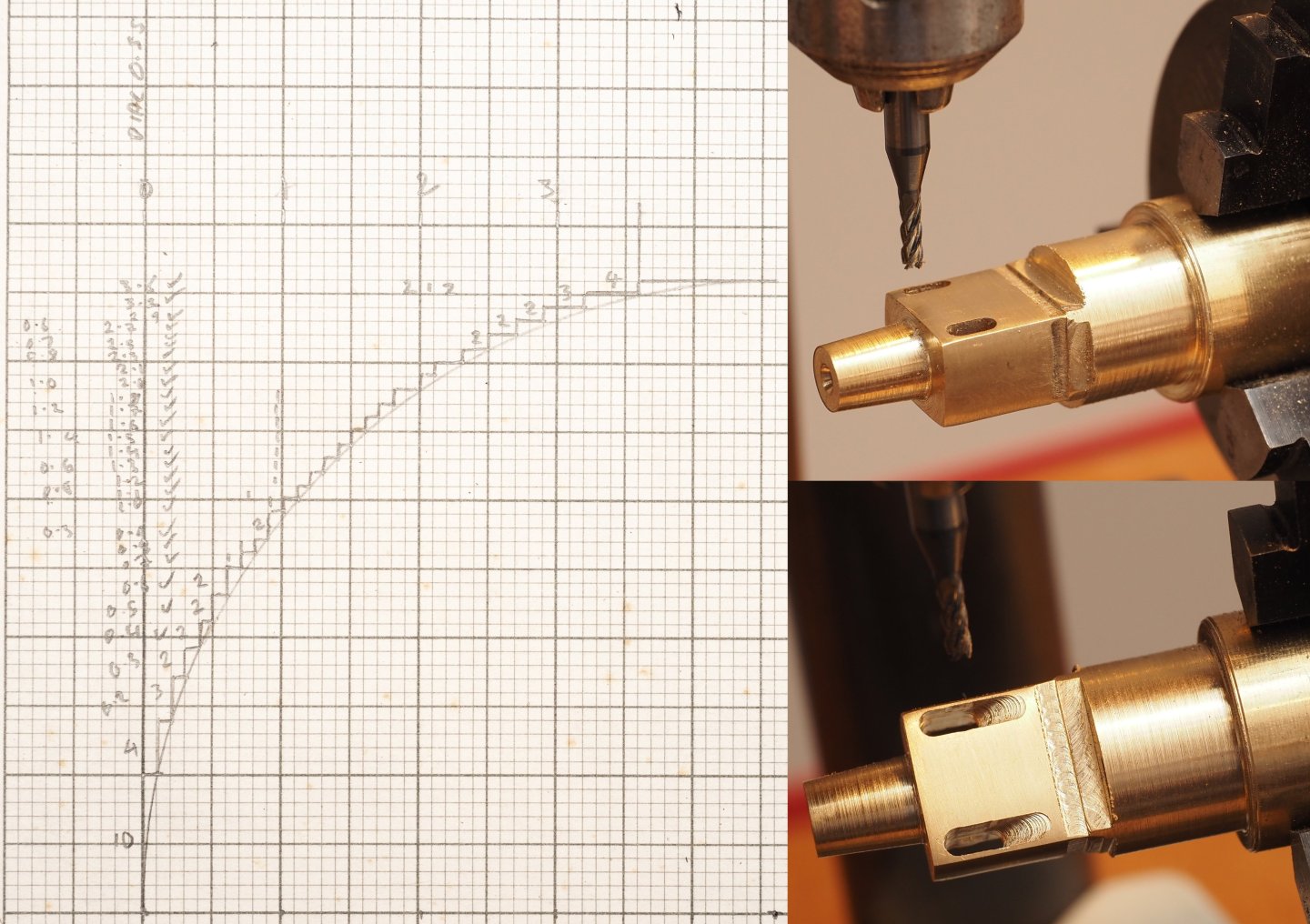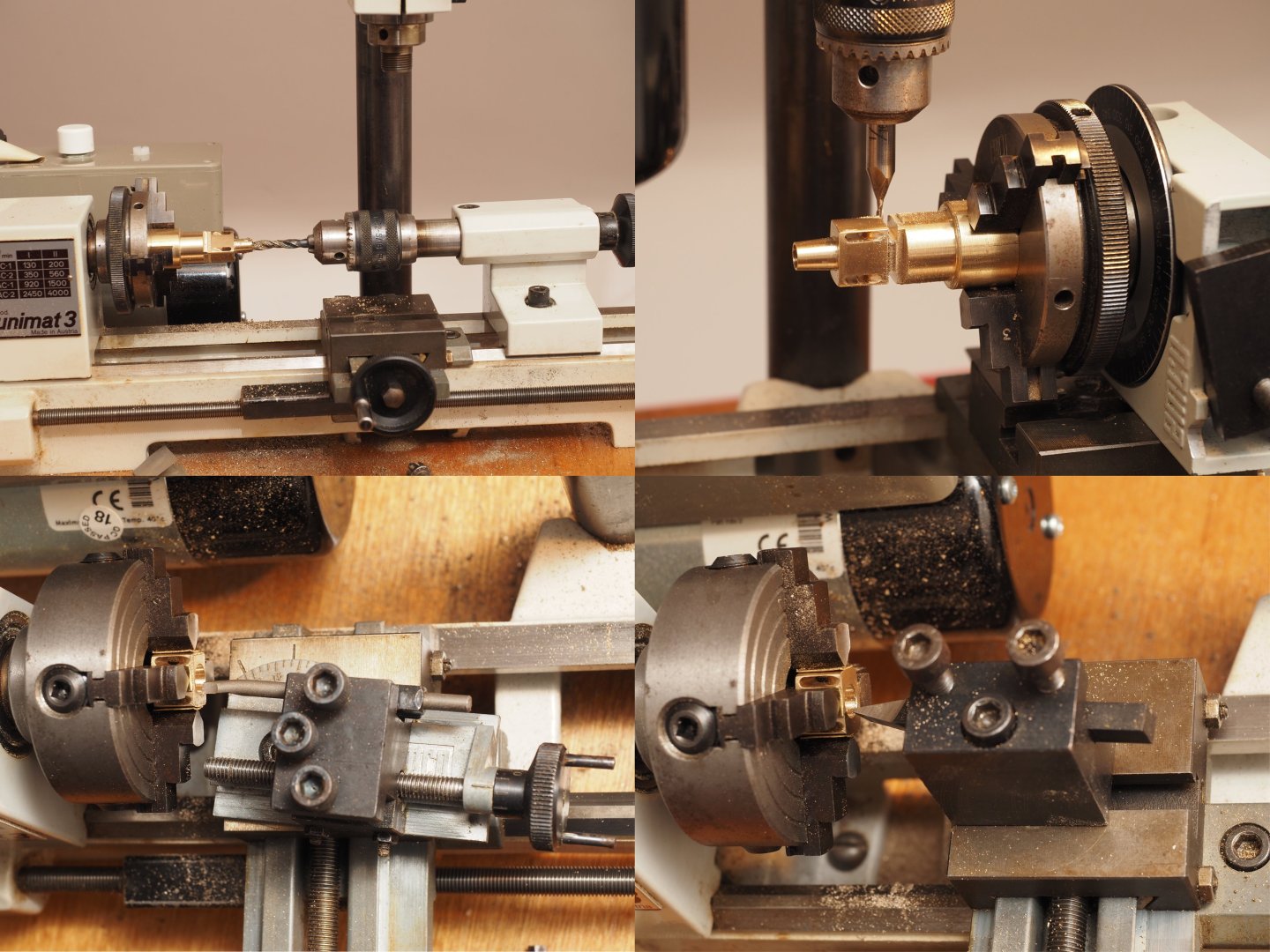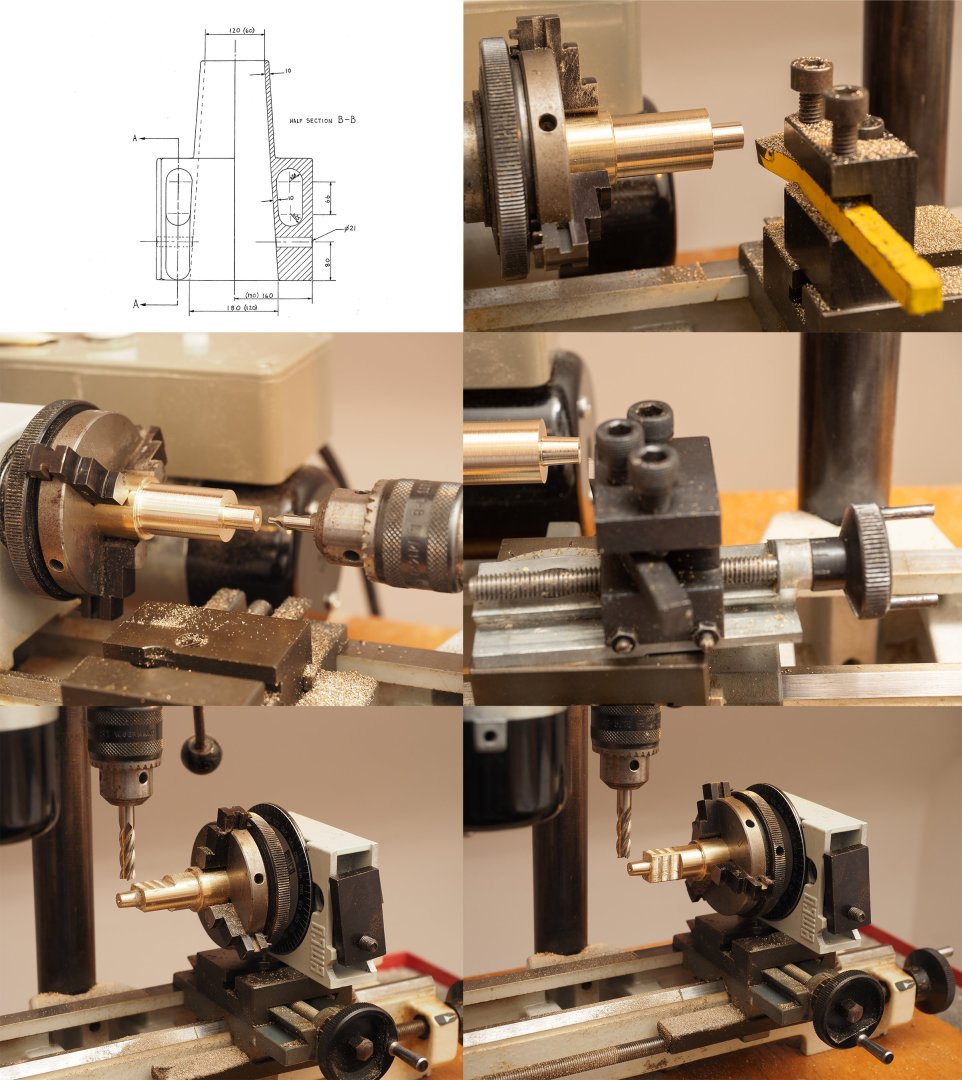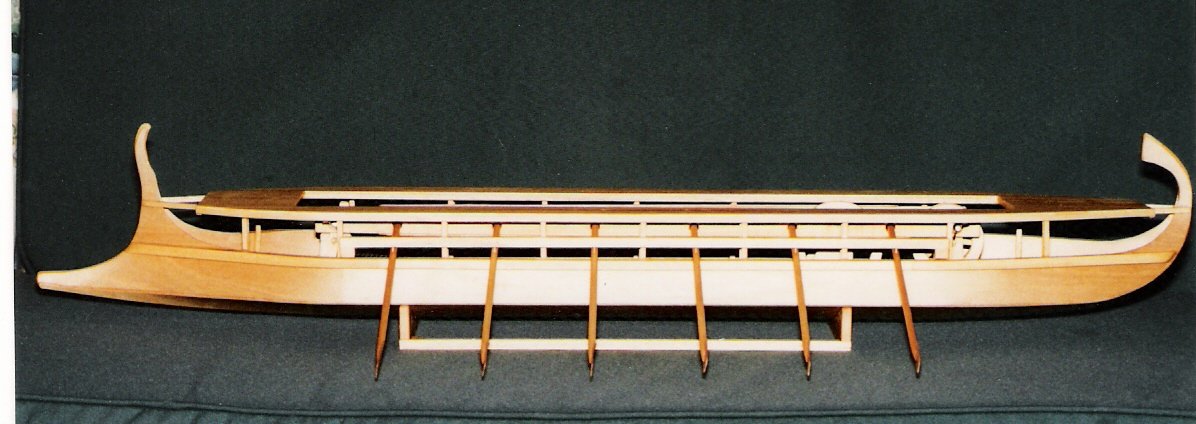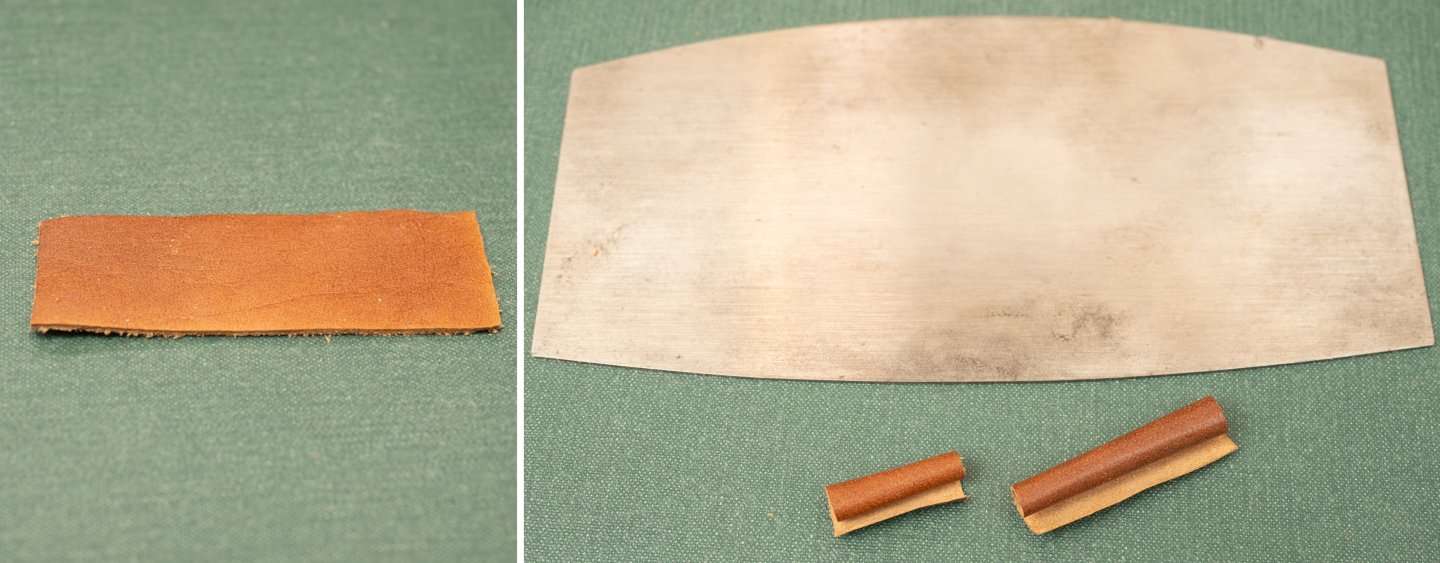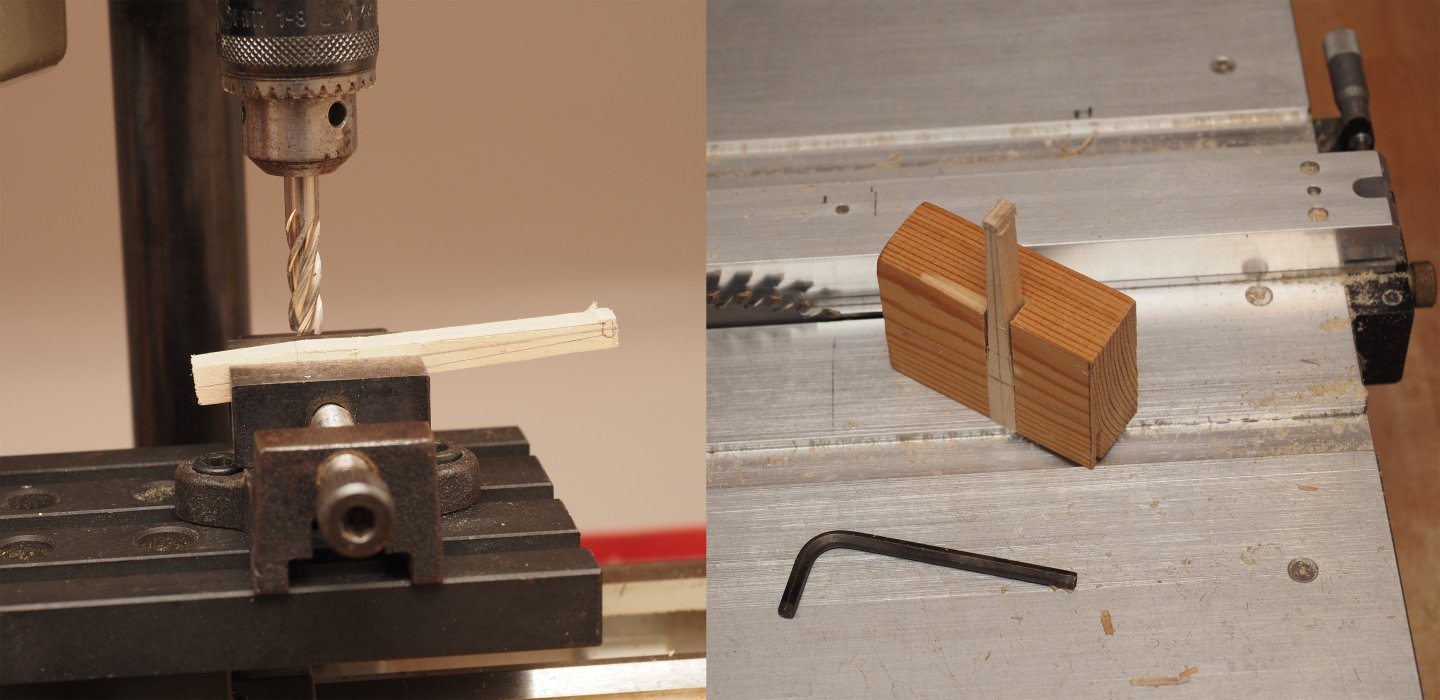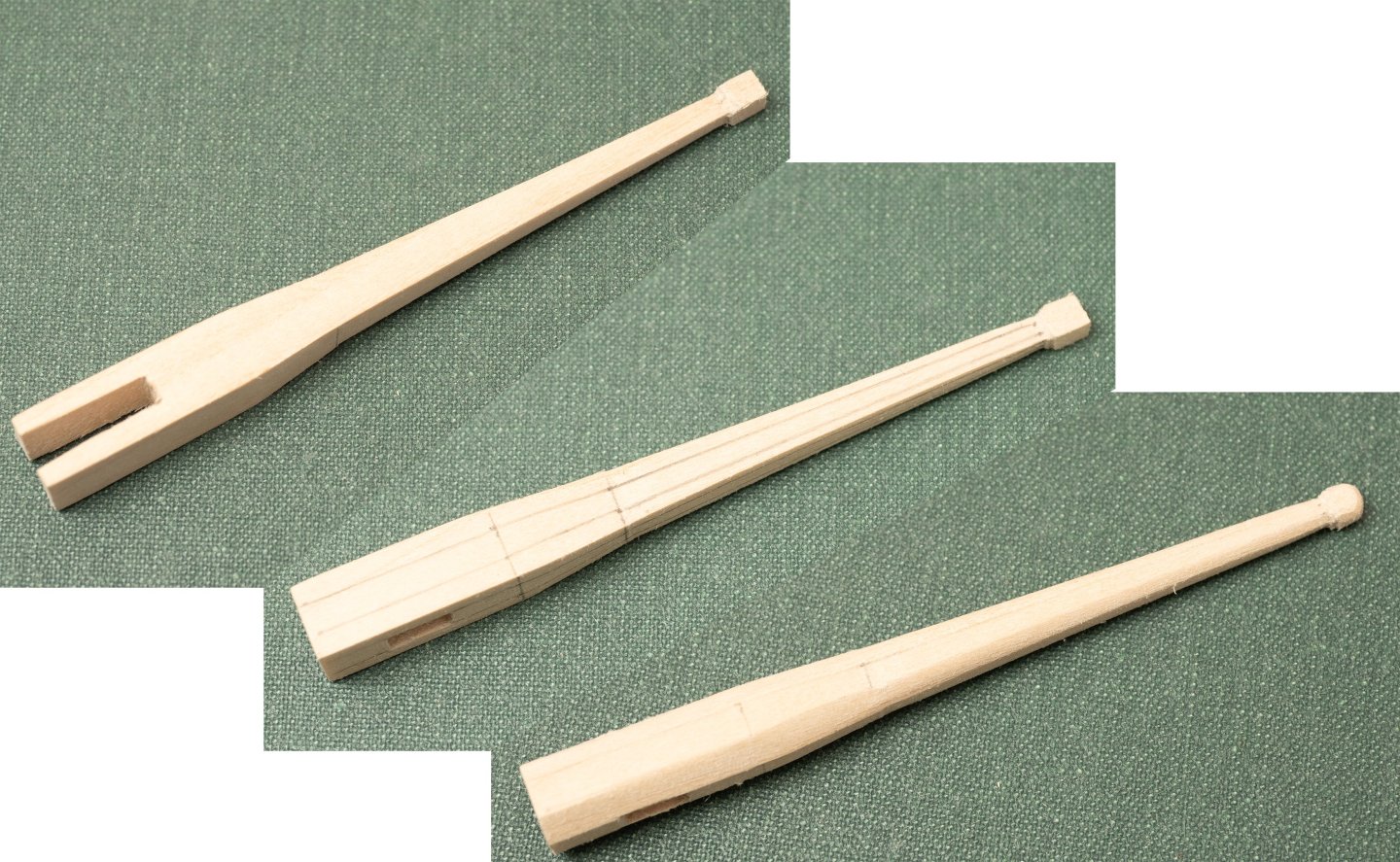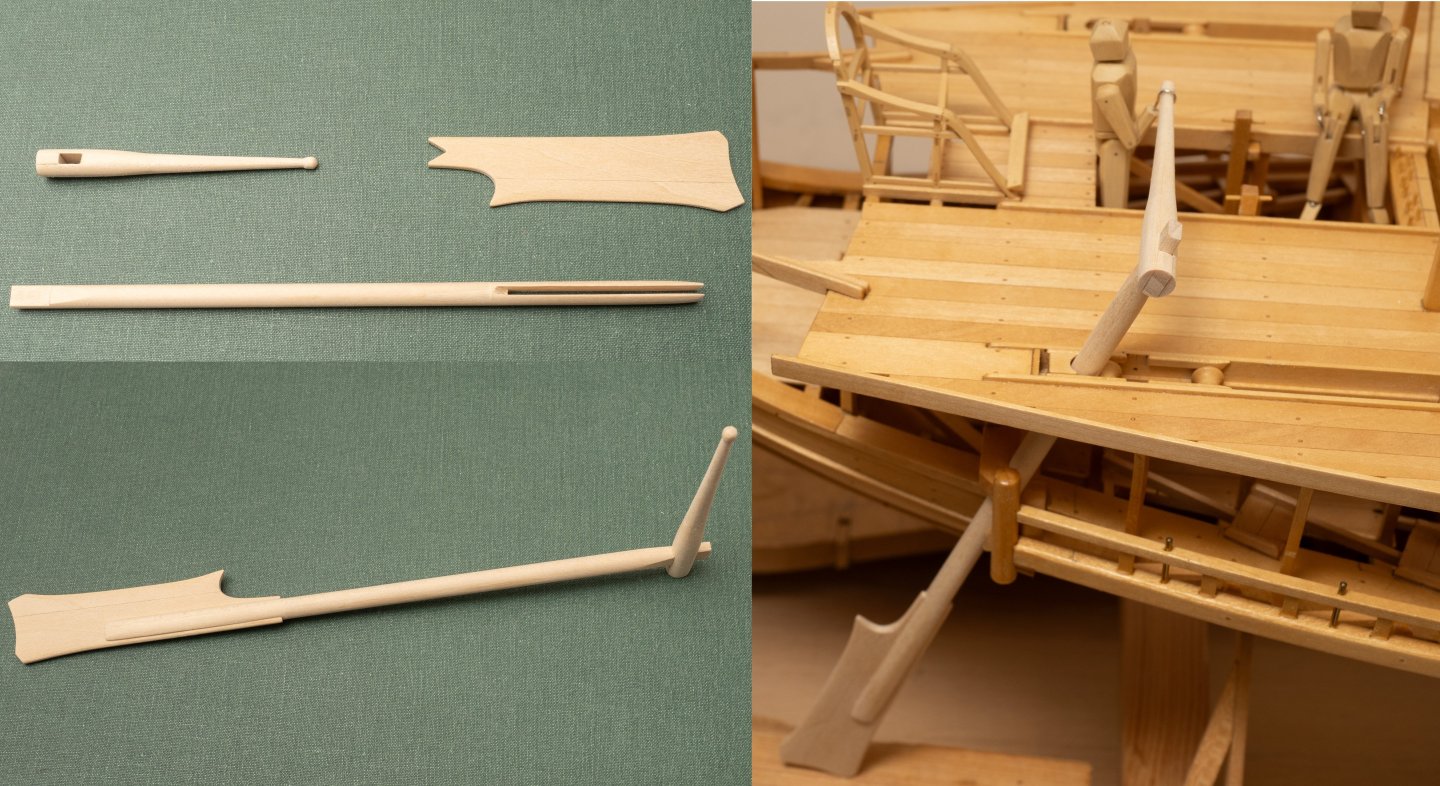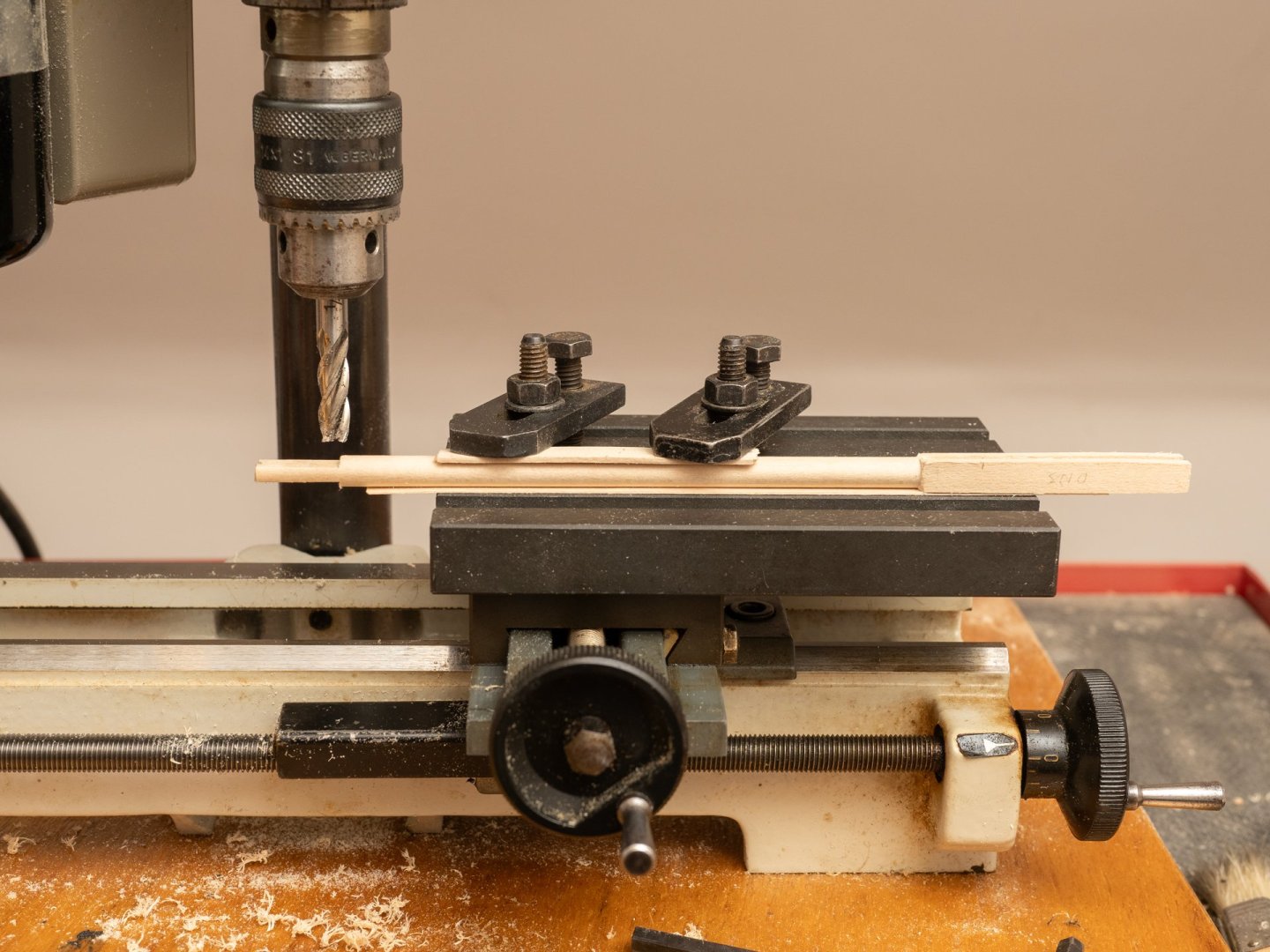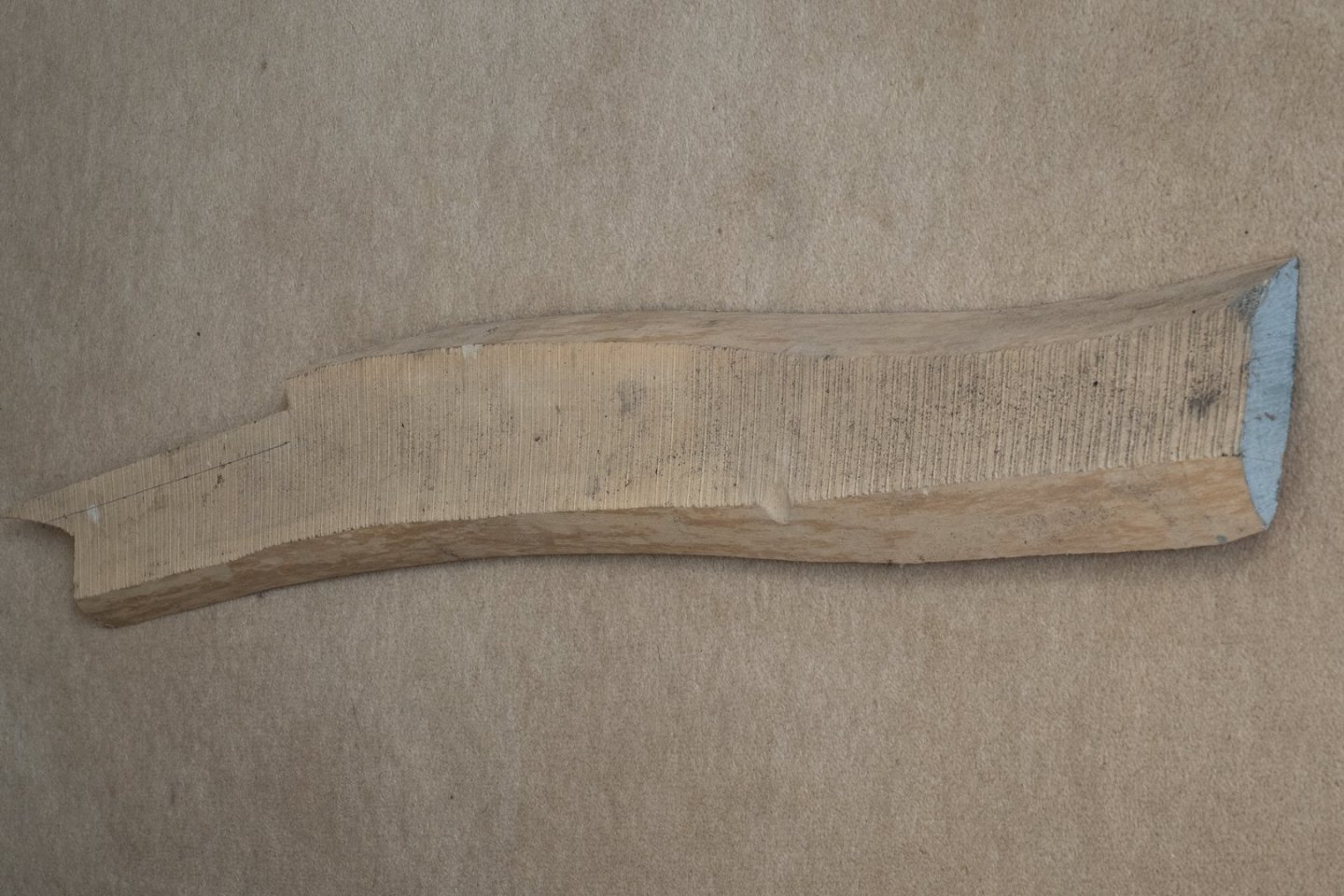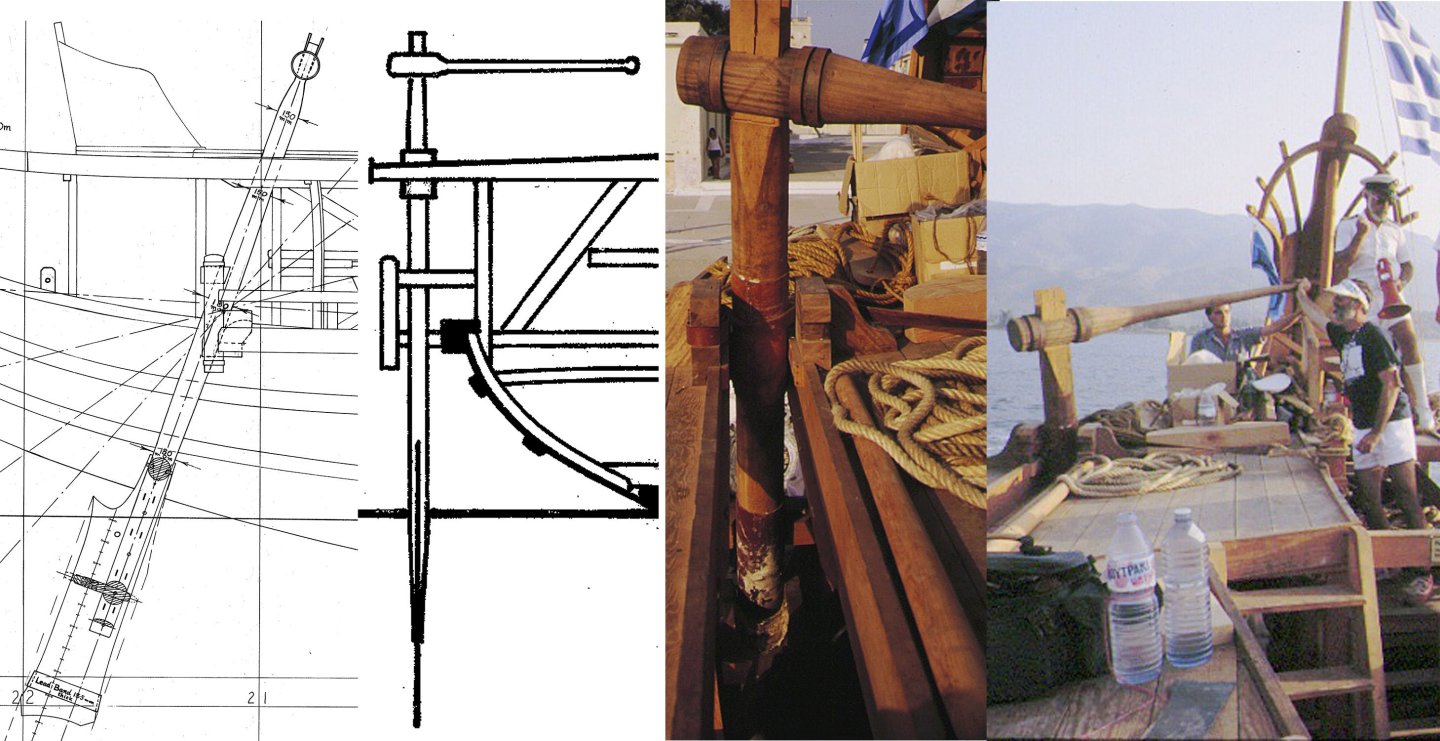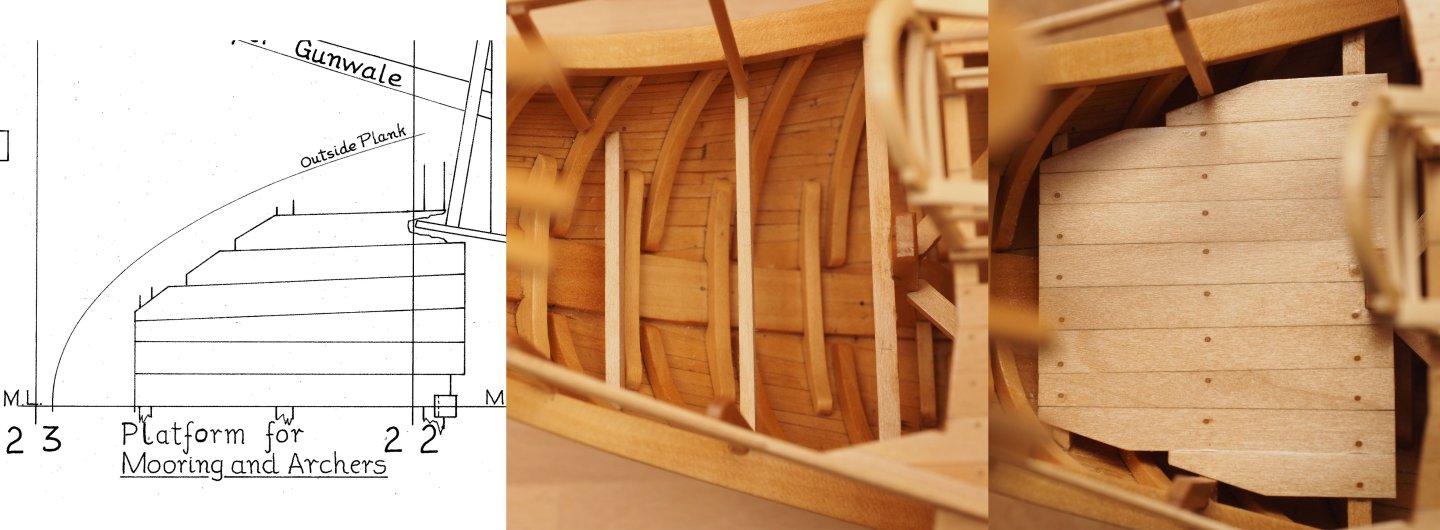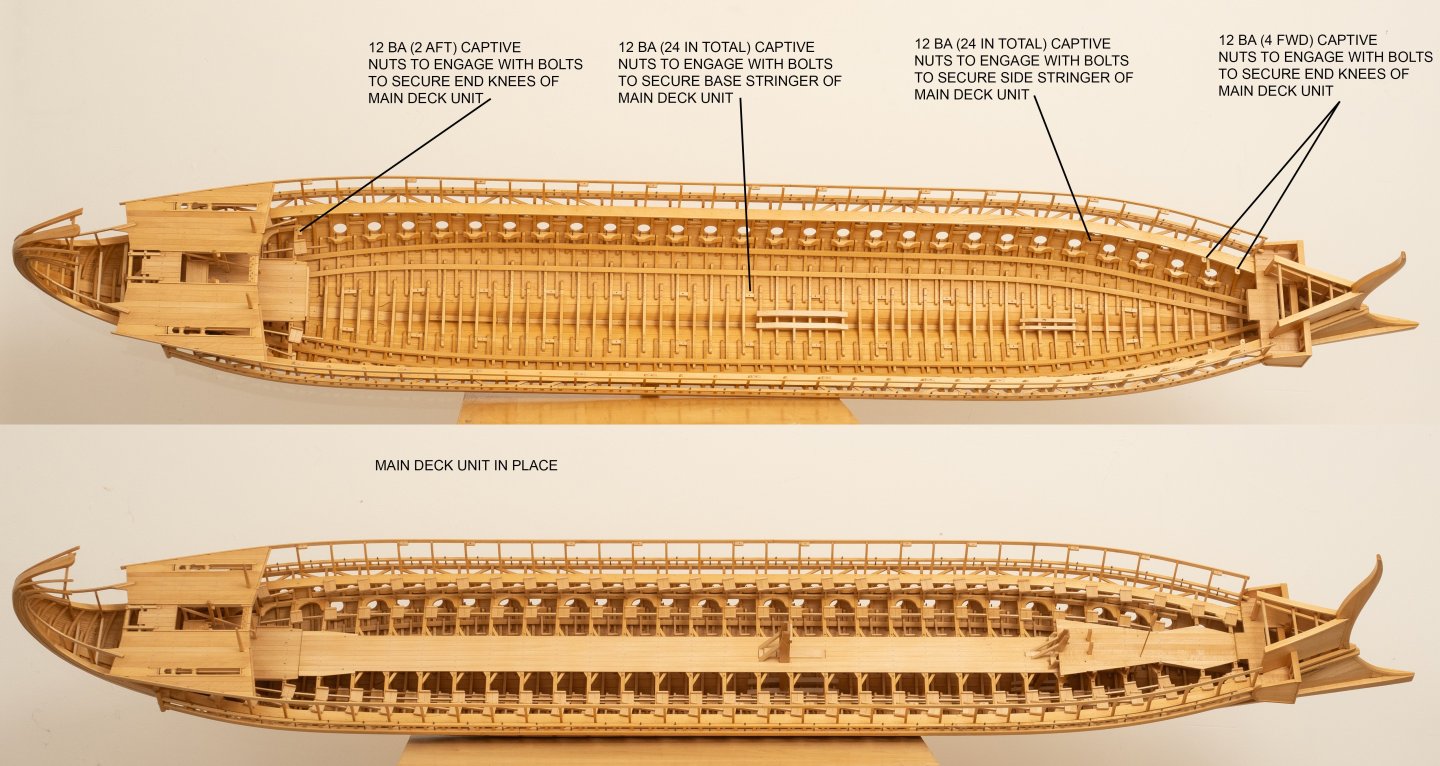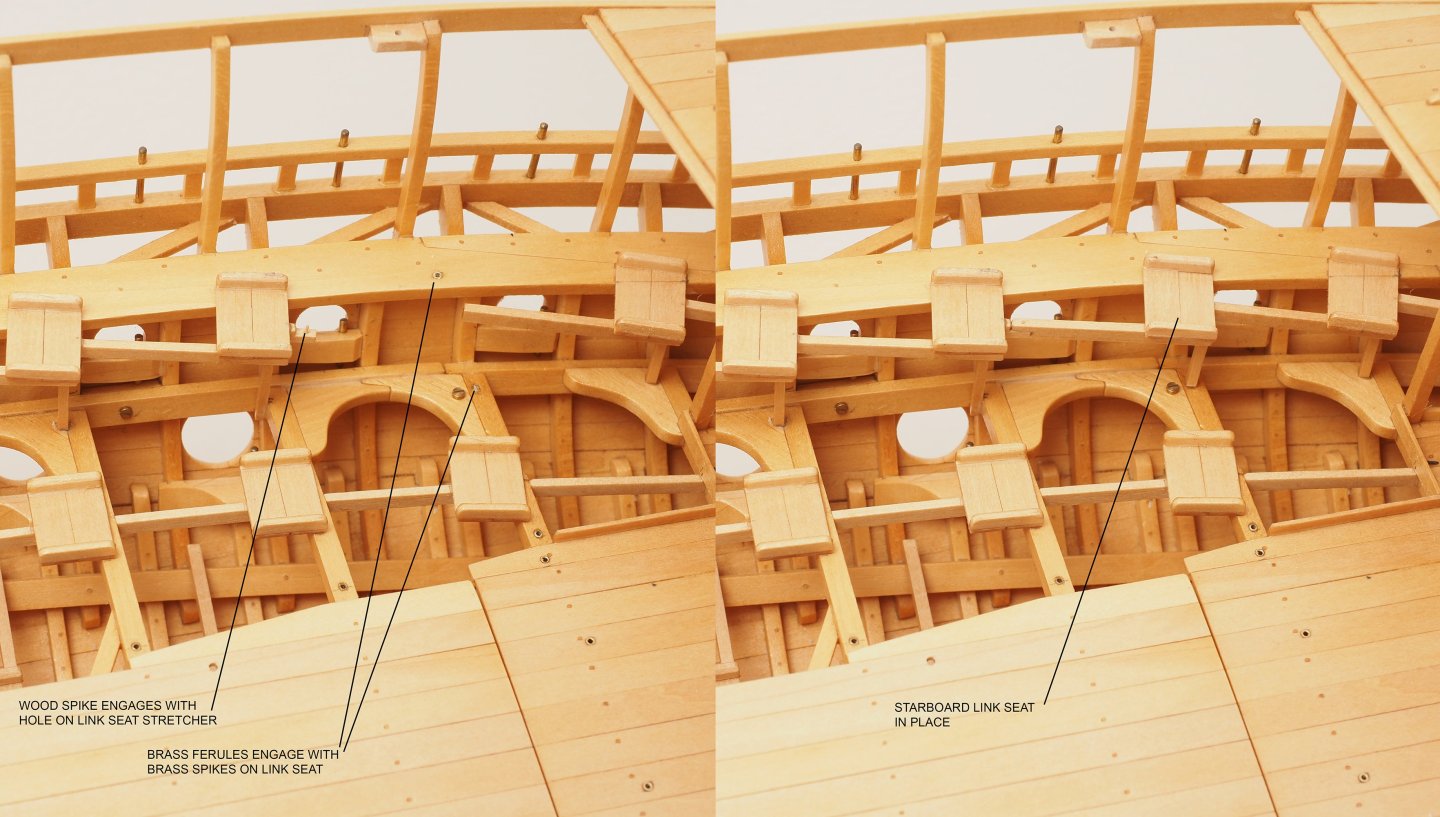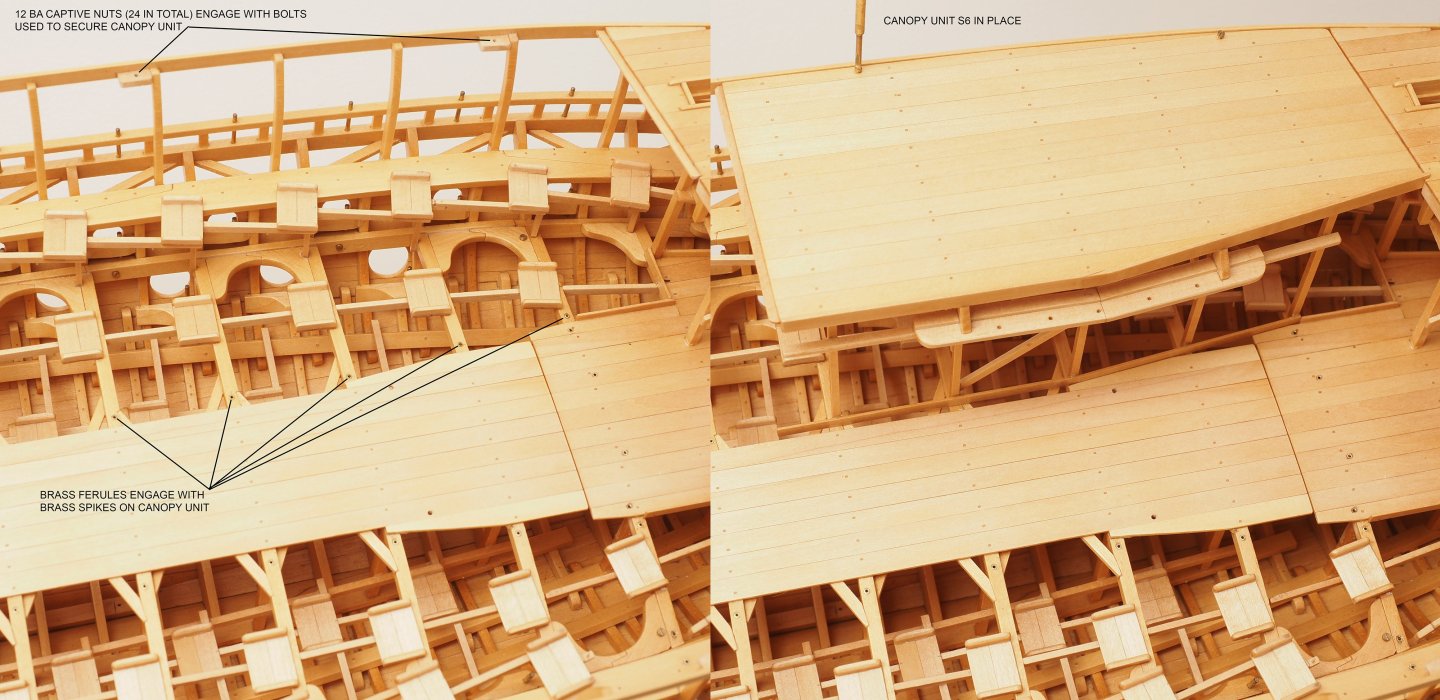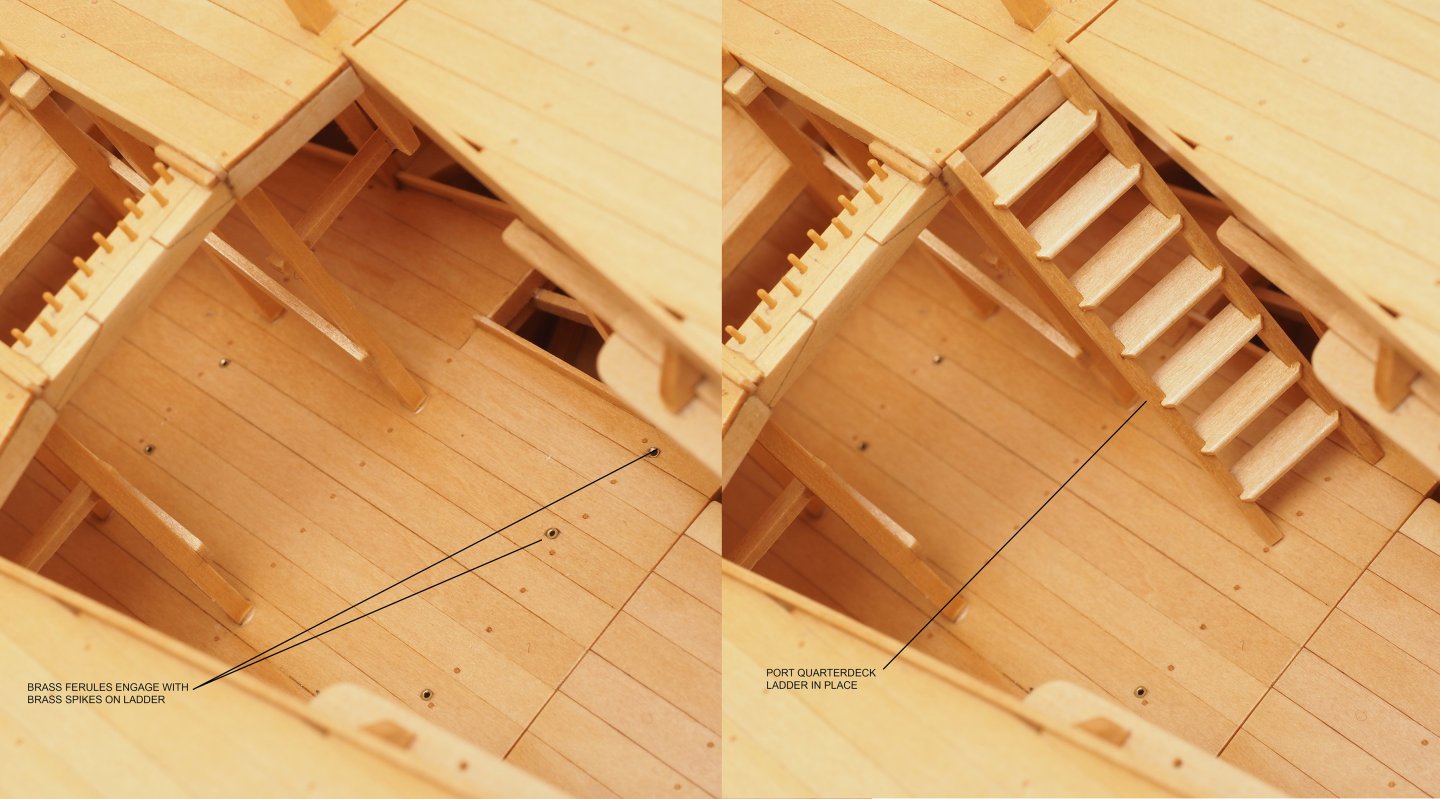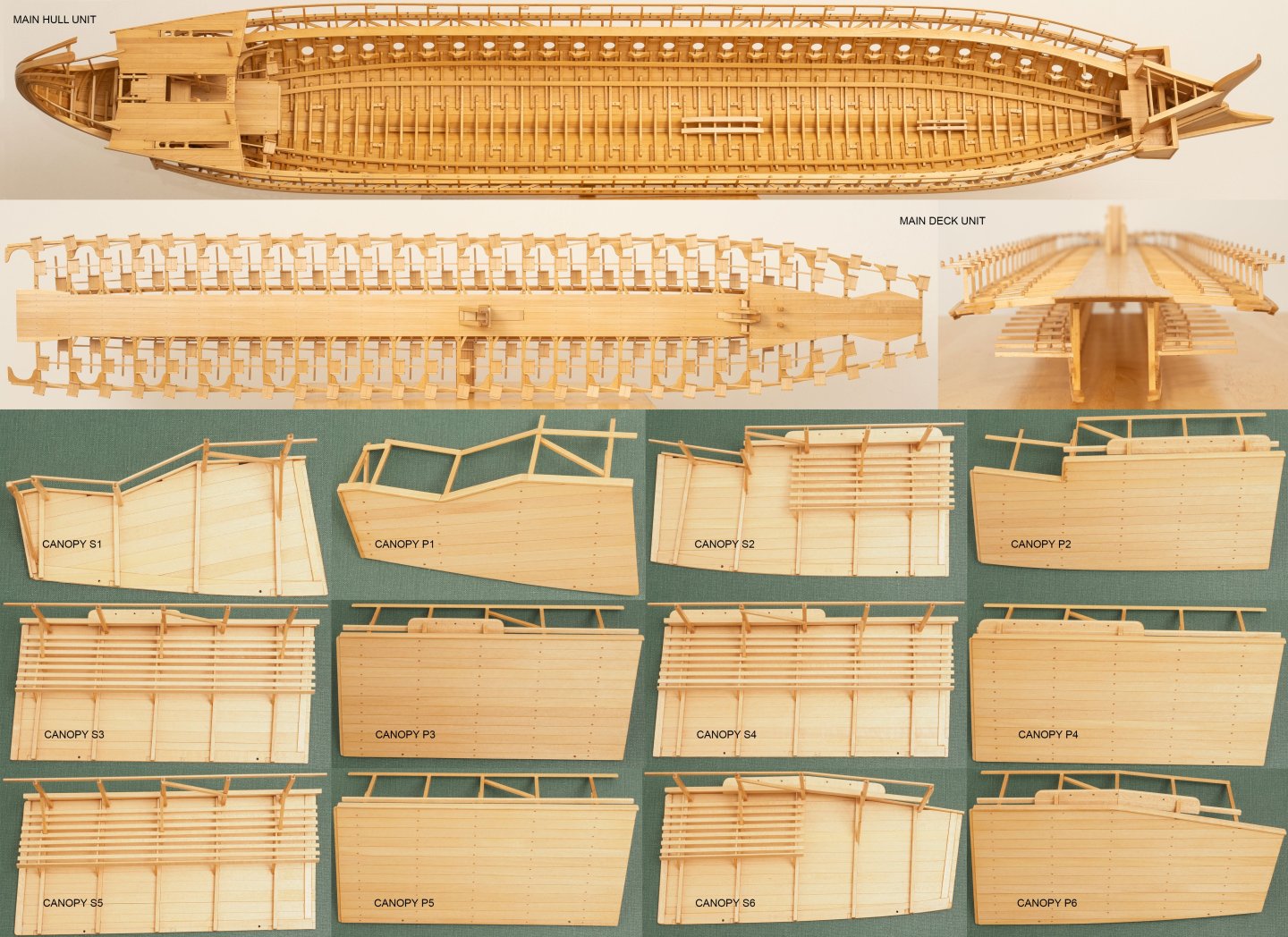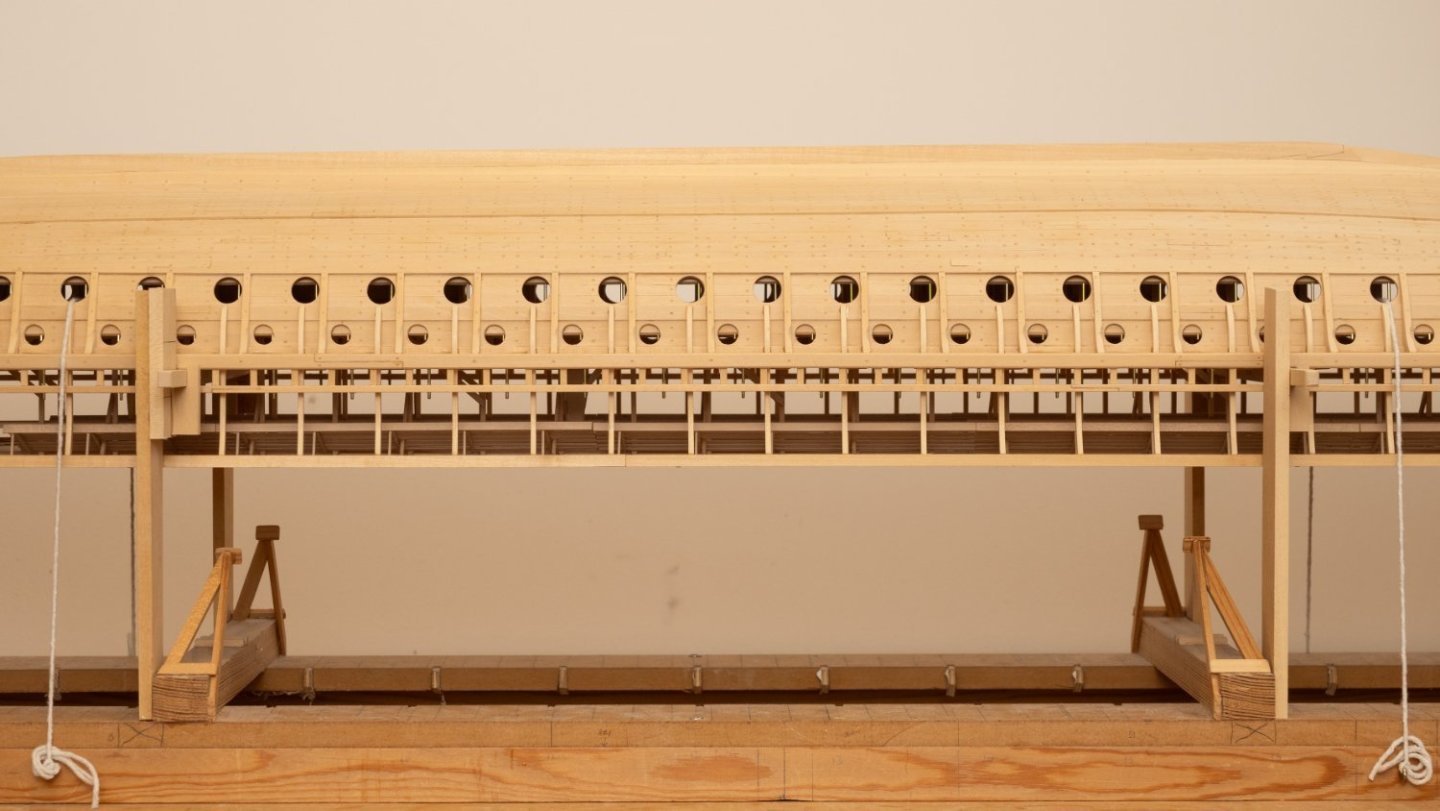-
Posts
220 -
Joined
-
Last visited
Content Type
Profiles
Forums
Gallery
Events
Everything posted by Richard Braithwaite
-
Ive chosen the same wood to build the spars (Lime) as used for the rest of the hull. Spruce might have been nice but I always think the grain looks abit to big at this scale. Her is the Main mast tapered and marked out for "octagonalizing": The base of the mast is square where it fits into the tabernakle and the top is tapered to fit the mast head fitting described earlier. The square base is finished with a radius at the forward edge to make raising and lowering the mast easier: Finally, both masts with their masthead fittings:
-
More experimenting with rope... Ive never been much good at eye splices, so I had a refresher session with some full size rope (polyester 20mm diameter) and then tried with some of "Ropes of Scales" 1mm polyester. I got a few of my tucks out of sequence but it seems to be feasible at this scale (if a little fiddly..) - I just need some more practice!
-
Ben from Ropes of Scale was kind enough to send me some samples of his excellent polyester and cotton ropes to help me decide on a way ahead for the rigging. Here is a picture of his 1mm polyester rope passing through the main masthead casting alongside an extract of drawing MSR 7 by Owain Roberts ( © Estate of John F. Coates, reproduced with permission) and a photograph of the full size ship. the polyester runs satisfyingly freely over my machined fairlead radii, which is nice... The photo of the full size ship shows shrouds in addition to the fore and backstays specified in the design by Owain (see discussion above). Interestingly while hemp was specified for the shrouds and stays, polyester rope was specified for the main yard lifts for safety reasons... The next image shows images of Bens polyester rope and cotton rope made off onto the main bits. I have some more experiments to do with sp;icing, rope coils etc. but I think I'm inclining towards polyester rope (although the slightly "furry" cotton, at 1:24 scale, looks quite like the full size hemp on Olympias in a lot of images...). Im also quite keen not to provide too much food for moths etc on my boat...
-
Interestingly I went to a talk, in Dartmouth, last week by a man who has been building lovely models of atmospheric steam engines since the 1970's (Home - David Hulse Steam Engines). The top of the boiler of one of his engines is made of lead and it has been in a sealed case together with Japanese Oak for 50 years. He says he has seen no deterioration at all...
-
Some images of the remainder of the machining operations for the main mast truck. The graph paper images illustrate a method I have for machining complex shapes manually turning the feed dials as a sort of poor mans CAM! Requires quite a bit of concentration to make sure I am turning the right dial the right way and in the right sequence! Particularly for the radii inside the halyard fairleads where I couldn’t see what is going on. After machining all the “steps” it’s a case of using files and sandpaper to smooth out the surface…
-
Another source that may be of interest: The Naval Architecture and Oar Systems of Ancient Galleys, J Coates, Chapter 9, The Age of the Galley, Conway Maritime Press 1995. Contains J Coates interpretions and drawings of Helenic Pentaconters, Biremes, Trirmens, as well as later Roman Galleys (Liburnians, Fours, Sixes etc.), as well as a good summary discussion of the design drivers explored by the Trireme Project. There is a particularly useful general arrangement and lines plan of a Roman Liburnian based on the Lindos relief and the ships on Trajan's column, which could be a good source for a simpler galley model, ("only" 50 oars, 20m long...). I think it was prepared for a planned full size reconstruction at some time and would make a really nice model... If anyone is interested it would be worth contacting the Trireme Trust archivist to see what else is available for this reconstruction.
-
Now turning my attention to the rig, I made the decision to model the rig as designed by Roberts (Ref The sailing Rig of Olympias, O.T.P. Roberts, The Trireme Project, Oxbow Monograph 31, Oxbow books 1993) rather than reflect the changes made to the rig during build and subsequent sailing trials. The most significant difference involves the shrouds. Roberts states that the masts of Mediterranean vessels of this type and period were without shrouds and merely stayed fore and aft (hence the substantial tabernacles fitted – see above). Pictures of Olympias, however, clearly show shrouds fitted but Roberts states that these were fitted because “Captain Dimitris Papadas…..took fright when seeing the tabernacles into which the masts were to be stepped and insisted that shrouds be fitted”. “Unfortunately, he fitted shrouds as in a fore and aft rig which made it impossible to brace round a reefed square sail”. As an aside, it is worth getting hold of these references on the Trireme Project (Olympias) for anyone interested in ships of this period and type. There were lots of papers presented by a lot of collaborators documenting the design and the trials, with a huge amount of information and discussion about all aspects of design and operation. I can give you a list of what I have (and what Ive found useful) , or you can contact the Trireme Trust archivist at Wolfson College. So, I’m going to model the rig as designed by Roberts, rather than as built (it is also a lot easier for me to omit shrouds into my disassembling design…). Roberts design for the rig is documented by drawings MSR 1-10. Starting with the masts drawing MSR 2 states that the head of the mast should be “tapered to fit the truck casting”, so it makes sense to make the truck casting before the mast… Twin Halyards pass through the mast truck to hoist the main yard. In Roberts design these trucks are bronze castings that include fairleads for these halyards and a shoulder above them to support the forestay and backstay. The castings for both main and foremast are defined by drawing MSR 7. I decided to machine these fittings from brass bar stock rather than cast them. It has been some time since I’ve done a significant metal machining project with my little Unimat Lathe, and this project enabled me to refresh myself with a wide range of its capabilities (including a first outing for the 4-jaw chuck that I just managed to get hold of on eBay!). The first steps are shown below (includes extract of Plan MSR 7 © Estate of John F. Coates, reproduced with permission):
-
I think the best approach is probably to turn using the oars. I would prefer to stop oars on the inside of the turn (either out of the water or in the water for more effect). The boat should definitely turn then as it will only have thrust from one side. Olympias (full size) achieved its tightest turns using a combination of rudders and rowing ahead on one side only, so using the oars to turn would be an authentic way to manoever . If your boat is directionally unstable you could help that by fitting a skeg at the back end. If there is any wind at all the situation will get confused as it will acto on the hull above the water to turn it one way or another - best to only use the model on a still day (or an indoor swimming pool!).
- 536 replies
-
- Quadrireme
- radio
-
(and 1 more)
Tagged with:
-
As for model rowing boats performance, you do have to modify your expectations based on the scale effects. Different aspects of the boats performance will scale differently. One critical aspect is that if you operate the vessel with an appropriate stroke rate (e.g. 45 strokes per minute) the maximum speed can never be more than the speed of the oar blades relative to the boat. This should actually look quite realistic (e.g. the model will travel at a speed roughly equal to full size speed multiplied by the scale factor), but the speed will be far to low for the hull to behave as full size (e.g. the bow wave and wake will be infinitesimal on the model) and too low for the rudders to act as they would on the full size boat. One way around this would be to increase the stroke rate massively (which would look ridiculous and also be difficult mechanically) to achieve a hydrodynamically scale speed for the hull (Froude Number) The other thing to watch out for is that wind effects scale massively for a small model. A very light wind is the equivalent to a full size gale and will stop the model dead. I made a very simply model of a rowing machine, prior to starting on my Olympias model. Only 12 oars operating in a simple circular path: I also produced a simple spreadheet to simulate the physics of the model and carried out some trials to validate the spreadheet with the model: Rowing Machine Calculation.pdf As you can see the model managed a speed of 91mm/sec at a stroke rate of 45spm. Quite slow and, but looked about right for the "scale". I also tried the model out crossing a reservoir on Dartmoor. I chose a day with no wind at all and it looked quite convincing as it made its way accross the lake...I didnt have any rudders, so i could only go in a straight line!
- 536 replies
-
- Quadrireme
- radio
-
(and 1 more)
Tagged with:
-
Steering oar and tiller assembly with metal bands and leather bearings: On Olympias they are fitter with lead straps around the steering oar blade to overcome buoyancy. I sourced some lead sheet of the right thickness (0.8mm equivalent to 18.5mm full scale...), which is sold for use as fishing line weights...However, reading about the disastrous effects of acetic acid on lead fitted to wooden models (Ref "Lead Corrosion In Exhibition ship Models, D. Wegner, NRG, Vol 43, No1), I decided against fitting. I will probably fit something made of brass at some point, but for the moment Im leaving as is... Here they are installed on the model, ably demonstrated by one of my trusty marines: On Olympias they are held up by ropes made off to the cleats either side of the helmsman, so that he can adjust the height of the oar (the hole for fixing these to the oar blade can be seen just behind the stock. I plan to fit thesee ropes once Ive made a decision on what rope material I am going to use.
-
Making up some brass bands for reinforcing the tiller mortice. A bit of a refresher as I havent done any metalwork like this for some time. Process as follows: 1. soldered with a solder/flux paste in a syringe and heated with a small dremel blowtorch, which seemed relatively straightforward. although you end up with a silver line where the joint is (unsurprizingly!)... 2. made slightly undersize and lightly hammered on a mandrel until the right diameter to fit the tiller. 3. Pickled in acid and cleaned up with ultra fine wire wool. 4. Placed in a jar above some amonia for about 15 seconds which gave the brass quite a nice "bronze" look. Resulting rings ready to install: Here they are on one of the tillers:
-
Preparing the leather for the rudderstock protection in way of the upper and lower bearings. Ive started with some leather (cow hide) about 1mm thick and thinned it down to about 0.2mm (approx 5mm thick at full size). It took a few attempts to do this without tearing the thin, fragile material. In the end I found it was easier with a large steer furniture scraper rather than a scalpel due to the more even "scrape". Now need to do some experimentation to find the best means of fixing (evostick or epoxy?) and final cutting to size (leather expands slightly when glue is applied to it). Photo below shows original 1mm hide and finished pieces (for upper and lower bearings) alongside one of the scrapers used.
-
As mentioned above, the tiller is not completel;y defined in the John Coates drawing pack. The following sketch is my best guess at the dimensions from scaling from the drawings and photographs of the full size ship: I originally thought I would turn this on my Unimat, but evantually decided to mill the tapers and then round it by hand using the general method for shaping spars. The image belos includes a jig intended to hold the tiller squarely against the fence of my Byrnes Table saw for cutting the slot for the rudder stock tennon: Then rounded by hand in the usual way: Here are the components of one of the rudders (showing trial assembly on board) prior to fitting leather and metalwork:
-
Back to work again after a travelling break... Unimat setup for milling the tennon at the head of the rudderstock:
-
I sliced up a substantial holly log about 30 years ago. The log was 9 inches in diameter and I cut it into 1 inch thick planks. I sealed the ends with aluminium yacht primer (because I had a tin lying around...) and stacked the planks separated with 1" pine stock for drying. The planks did distort a bit during the drying process and a mould did develop over the surface during the first year (while the sap was still wet). I also remember getting quite worried that my lovely wood would be wrecked! However, as far as I remember, once it had dried I was able to brush the dead mould off the planks. 30 years later the holly is a lovely creamy white throughout. So Im sure yours will be fine in a few months time. I still have most of it left, awaiting a suitable project. The photo below shows one of the plank with a chunk taken out to make some of the finer bits of my trireme model (e.g. the Trierarchs chair https://modelshipworld.com/topic/21958-trireme-olympias-by-richard-braithwaite/page/4/ ) , where something harder and more precise than lime was needed. Holly is just about my favorite wood for model boat making. I think the grain does a passable imitation of oak in miniature and it can be carved as fine as paper if needed.
-
The text on the photos above was created in photoshop, which is the progam I use for general photo processing. There are lots of lower cost alternatives available however. Ive even found Powerpoint as quite an effective solution, particularly for lower resolution images where you can simply take a screenshot of the annotated "slide".
-
The design of the steering oars is not particularly well defined by the drawing pack (at least the drawings which I have copies of…). The best information is probably on the Stern Profile and Plan drawing (Plan 12), although this only shows one view and does not define the geometry of the tillers. The general Arrangement Drawing (Plan 1) does show another view, in low resolution which does at least help the overall tiller dimensions. Taken together with images of the completed Olympias, these form a reasonable definition of the design for my model (extracts of Plans 1 and 12 © Estate of John F. Coates, reproduced with permission: The steering oar stocks were originally designed at a diameter of 150mm throughout and the design of the upper and lower bearings shown in Plan 24 sized for this diameter. John must have subsequently concluded that the bending stresses at the lower bearing would be too great and increased the diameter in this area to 180mm as shown in the extract of plan 12 above. The relevant parts of Plan 24 were redrawn to accommodate this increased diameter (Plan 24a). I built my rudder bearings to Plan 24 and so will be building my rudder stocks to a uniform 150mm diameter. It was a long time ago that I did this and Im not quite sure what my reasoning was… Ideally, I planned to build the model to reflect the build state of Olympias at her launch and original sea trials in 1988, but I must admit I have departed from that in some areas and built the model to reflect the design drawings (although even these contradict one another in some cases, as Ive discussed elsewhere in my build log…) Another post build addition that can be seen in the above photographs is the friction brake (wooden upstands with a leather strap attached to the rudder slot framing on the quarterdeck). Again, I dont have this in my model - at the moment... My lovely little Unimat 3 is just large enough for me to turn the stocks for the steering oars. Here is a blank (Lime wood as usual, but a bit denser than used for most of the hull structure) Ive roughly rounded one end, manually, to fit in my 3 jaw chuck and glued a 12BA brass nut in a recess in the other end to reinforce the center hole (first attempts, without this led to the center point tearing out…) Here is the blank in position in my Unimat. As you can see I’ve even had to overhang the center point holder on the right hand side somewhat to accommodate the length… Here is the blank turned down to 6mm diameter (150mm at full scale) with on end left square (and reduced in size using my Byrnes table saw – my other favorite tool in my workshop!) to accommodate the slot for the steering oar blade.
-
Left planking of the forward and aft platforms until after varnishing the main hull unit, in order to improve access (it was already difficult enough underneath the fixed quarterdeck structure...) Plan 21, an estract of which is shown below (© Estate of John F. Coates, reproduced with permission) shows the planking of the forecastle planking stopping short of the port and starboard extremities (I guess, because there is no beam for the forward edge of any plank to rest on...). As you can see in the image below, ive gone along with this despite the obvious hazard involved with getting a foot caught up in the gap if the ship rolls at the wrong moment... The aft moogin platform is shown in Plan 23 , an estract of which is shown below (© Estate of John F. Coates, reproduced with permission) together with my interpretation, which has ended up a bit wider at the aft end...
-
Putting it all back together: Som images showing how the main units go back together after varnishing. The main deck unit is placed inside the main hull unit and bolted together using a couple of brass screwdrives I made for the purpose (some of the bolts are quite fiddly to get at now all the seats are in place... The photo shows one of these screwdrivers accessing one of the difficult to get at bolts securing the base stringer. I made a couple of "Link Seats" to connect the thranite seats at the aft end of the main deck unit to the ones fixed under the quarterdeck: Then its a case of securing all 12 Canopy Units: The assembly with all main units in place: There are a number of other loose outfit fittings, like ladders to go in: Complete assembly takes me about 1 hour at this stage. Hopefully I wont need to take it appart again for some time...
-
In my case Im building a model of a modern reconstruction of a Greek Trireme (Olympias) rather than a model of a Greek Trireme. Early photos of Olympias sugest it was coated with some sort of Yacht Varnish, which was probably Polyurethane.... But the main reason I used polyurethane was because Ive used it before and Im used to it...
-
Current stage of varnishing complete. Please to say, none of my fears materialised: 1. The older work didnt look any different from the fresh stuff. 2. I managed to avoid blocking up the threads of all the captive nuts 3. The lightweight structure didnt distort. Composite image of all the main components after sealing: As an aside Ive got myself a new umbrella reflector kit to use for flash photography. It came with 2 umbrellas. These photos were its first outing, so still getting used to it... Im alreadyquite pleased with the "soft" white one which seems to give quite an even illumination (when I point it in the right direction!) with nice soft shadows...
-
Main hull unit and main deck unit now coated with 5 coats of Polyurethane Matt (thinned 25% with White spirit) and Ive started the first coat on the deck canopy units, ladders and other misc bits and pieces. It took me four full days to sand where I could (600 grit) before I started and 7 full days to apply the 5 coats to the 2 main units with a brush (sanding between coats with 1500 grit paper). Very fiddly work, there are a lot of brackets, stanchions etc that are quite difficult to brush around - even with the model fully dissasembled. I could probably have done it quicker with an airbrush, but dont have much experience using them so went for the brush in the end. I am quite pleased with the finish I achieved. Even the older wood (worked over 10 years ago) has some up nicely and is indestinguishable from the fresh wood (e.d. tabernacles and stowage racks). I was really relieved to find I could fit the deck unit back inside the hull unit (after varnishing) and bolt it down with out any difficulty. I had managed to keep the threads of the captive nuts free of varnish and there was very little distortion of the two units from varnish absorbtion (the hull had opened up about 2mm - which I was easily able to pull back with the bolts to the beam shelf on the deck unit. Hopefully the canopy sections (even lighter built - and so even more sensitive to distortion) will behave as well. Photo below shows how the wood like looks now...
-
I am managing to sand most of the planked surfaces down to reasonably fresh wood, but there are some areas I wont be able to get at (eg. Internal hull planking between stifeners) and other areas that are made of such slender wood that to sand them risks damaging them (e.g. internal stanchions and rowers outfit). In order to see how much difference this would make to the varnished apearance I made up the test pieces (below) from some panking panels I made about 5 years ago to try out different trenails/ hole dimensions. 1. The one on the left was sanded down to "fresh" wood (350 grit followed by 600 grit) then cleaned with white spirit and coated with 5 coats of Ronseal, Ultra Tough Mattcoat Clear Varnish (polyurethene) - 1st coat thinned 50% with white spirit. 2. The one on the right was not sanded at all. Simply cleaned with white spirit and varnished. I was surprized at how little difference there was between the 5 year old and fresh surfaces (there are some pencil marks on the right hand panel which make it look a bit worse...). Im hoping that the difference wont be that noticable, particularly as it will be on different pieces of wood and there is natural variation accross the wood used anyway... The picture below is of a model I varnished (again , matt polyurethane varnish) 35 years ago (!) The hull planking is ash and is has darkened slilghtly over the years to quite a pleasing colour. Hopefully this aging effect will help to iron out any differences in wood preparation on my trireme.
-
The fourth evolution of my build cradle... The upper works are very light which makes inverting the model interesting. Ive adapted my cradle so it supports the model inverted on two beams which pass from port to starboard beside the upper thole pins. This way the weight is taken on the lower outrigger which is supported by numerous brackts and so should be strong enough to take any forces I subject it to while sanding and varnishing the hull.
-
OLYMPIAS DRAWINGS AND TRIREME TRUST ARCHIVE I have recently been in email corespondence with the archivist at Wolfson college who is responsible for managing this archive (Jude Brimmer). The point of contact she has given me is https://www.wolfson.cam.ac.uk/library/archives/trireme-trust , which includes both links to the catalogue and their contact form. She has permission to provide is a PDF ‘research pack’ of a selection of the drawings which the estate has chosen as being particularly suitable for modelmakers. (GA2 and Plan nos 7, 8, 10 and 11). she has been authorised to provide this free of charge, on completion of a Copyright Declaration Form stating it will be used for research/private study purposes only.
About us
Modelshipworld - Advancing Ship Modeling through Research
SSL Secured
Your security is important for us so this Website is SSL-Secured
NRG Mailing Address
Nautical Research Guild
237 South Lincoln Street
Westmont IL, 60559-1917
Model Ship World ® and the MSW logo are Registered Trademarks, and belong to the Nautical Research Guild (United States Patent and Trademark Office: No. 6,929,264 & No. 6,929,274, registered Dec. 20, 2022)
Helpful Links
About the NRG
If you enjoy building ship models that are historically accurate as well as beautiful, then The Nautical Research Guild (NRG) is just right for you.
The Guild is a non-profit educational organization whose mission is to “Advance Ship Modeling Through Research”. We provide support to our members in their efforts to raise the quality of their model ships.
The Nautical Research Guild has published our world-renowned quarterly magazine, The Nautical Research Journal, since 1955. The pages of the Journal are full of articles by accomplished ship modelers who show you how they create those exquisite details on their models, and by maritime historians who show you the correct details to build. The Journal is available in both print and digital editions. Go to the NRG web site (www.thenrg.org) to download a complimentary digital copy of the Journal. The NRG also publishes plan sets, books and compilations of back issues of the Journal and the former Ships in Scale and Model Ship Builder magazines.

